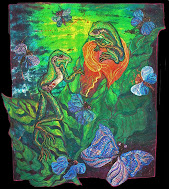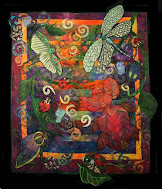Friday, January 15, 2010
Thread Savy-Basic Embroidery Thread
Thread information is one of the deep dark mysteries of the quilt world. It's so common we think we should know.
Like most things, it's more complicated than it looks. And like most things we should know, it's really unhelpful to should on ourselves.
There are many brands and I have my favorites. I'll talk about that another time.There are also whole lines of thicker threads, I'll cover later. But I'd really like to lay the basis of info you need to have about basic thread for machine and free motion embroidery.
Sewing and Embroidery Threads
Sewing threads are three ply threads made for holding pieces of fabric together. They are almost always an unacceptable embroidery thread because they are not made to lie on top of each other.If you sew over them consistently, you can make a surface similar to chain mail.
Embroidery threads are usually a two ply thread. They're finer and they are made to overlap and blend into each other.
Thread Sizes
Threads usually have two numbers on them. One will be a color number. The better quality threads are consistent color-wise and don't have dye lot issues.So you can buy the same color over and over with confidence.
But the other number is the mystery. We hear about 40 weight thread. What is that?
Thread sizes are an old measure system. It's really the thread count per inch. If you laid your threads side by side, how many threads would make an inch?
So a 40 weight thread would be forty threads, side by side. A thirty weight 30 threads. 200 count percale is two hundred threads to the inch.( The same system applies to linens as well). For embroidery purposes, any thread between 12-40 weight can usually work through a top stitching 90 needle( see my early blog on Needle Knows).
These threads can be used either in the bobbin or the needle, zigzag or straight stitch, computerized or free motion. They are the backbone of embroidery.
What's My Thread Made Of
Threads are made of a number of different fibers.Some are more successful than others. It's worth knowing how these fibers react when you choose your threads.
Cotton is probably the most basic embroidery thread. It's strong, comes in many colors and is versatile. It has one flaw that to my mind is unforgivable. It's not shiny. Magpie that I am, I will confess, I never use it.
Rayon is the most common embroidery thread. It has a lovely sheen and a fine color range. But it's never strong. Some brands are better than others. I use rayon that's in my sewing box. But I've stopped buying it for myself or for students, unless I simply can't get the color any other way. It's never as strong as polyester. In fairness, I do think it blends better than polyester. But the breakage is an annoyance I'm unwilling to offer to students or put up with myself.
Polyester threads are the gold standard of the 40 weight crowd. They're strong, and the color range is astonishing. They are my go-to, war horse 40 weight thread.
Acrylic threads truly lead me to ask the question, "Why?" These threads are so unstable I don't even want to see them in someone's stash. My personal experience with them has been too unpleasant for words. I can't recommend them. They seem to be set up for computerized embroidery, and perhaps they work better for that.
Garbage in, Garbage out
There are threads I consider a bargain. But when someone tells me about this wonderful thread they found that's so cheap, I do need to restrain my eye roll.Usually cheap thread is just that. It's not merely inexpensive. It's cheap. Save money on something else. You're time is valuable, and cheap thread usually wastes mountains of time in breakage and bad behavior. Old thread is also a case in point. It will get too old to use, and at that point is no bargain.
Wrapping it up
All that said, the real test of any thread is how it works in your machine.Keep track. You may find that your machine has very different opinions, and in the end, those are the only ones that count for you.
Like most things, it's more complicated than it looks. And like most things we should know, it's really unhelpful to should on ourselves.
There are many brands and I have my favorites. I'll talk about that another time.There are also whole lines of thicker threads, I'll cover later. But I'd really like to lay the basis of info you need to have about basic thread for machine and free motion embroidery.
Sewing and Embroidery Threads
Sewing threads are three ply threads made for holding pieces of fabric together. They are almost always an unacceptable embroidery thread because they are not made to lie on top of each other.If you sew over them consistently, you can make a surface similar to chain mail.
Embroidery threads are usually a two ply thread. They're finer and they are made to overlap and blend into each other.
Thread Sizes
Threads usually have two numbers on them. One will be a color number. The better quality threads are consistent color-wise and don't have dye lot issues.So you can buy the same color over and over with confidence.
But the other number is the mystery. We hear about 40 weight thread. What is that?
Thread sizes are an old measure system. It's really the thread count per inch. If you laid your threads side by side, how many threads would make an inch?
So a 40 weight thread would be forty threads, side by side. A thirty weight 30 threads. 200 count percale is two hundred threads to the inch.( The same system applies to linens as well). For embroidery purposes, any thread between 12-40 weight can usually work through a top stitching 90 needle( see my early blog on Needle Knows).
These threads can be used either in the bobbin or the needle, zigzag or straight stitch, computerized or free motion. They are the backbone of embroidery.
What's My Thread Made Of
Threads are made of a number of different fibers.Some are more successful than others. It's worth knowing how these fibers react when you choose your threads.
Cotton is probably the most basic embroidery thread. It's strong, comes in many colors and is versatile. It has one flaw that to my mind is unforgivable. It's not shiny. Magpie that I am, I will confess, I never use it.
Rayon is the most common embroidery thread. It has a lovely sheen and a fine color range. But it's never strong. Some brands are better than others. I use rayon that's in my sewing box. But I've stopped buying it for myself or for students, unless I simply can't get the color any other way. It's never as strong as polyester. In fairness, I do think it blends better than polyester. But the breakage is an annoyance I'm unwilling to offer to students or put up with myself.
Polyester threads are the gold standard of the 40 weight crowd. They're strong, and the color range is astonishing. They are my go-to, war horse 40 weight thread.
Acrylic threads truly lead me to ask the question, "Why?" These threads are so unstable I don't even want to see them in someone's stash. My personal experience with them has been too unpleasant for words. I can't recommend them. They seem to be set up for computerized embroidery, and perhaps they work better for that.
Garbage in, Garbage out
There are threads I consider a bargain. But when someone tells me about this wonderful thread they found that's so cheap, I do need to restrain my eye roll.Usually cheap thread is just that. It's not merely inexpensive. It's cheap. Save money on something else. You're time is valuable, and cheap thread usually wastes mountains of time in breakage and bad behavior. Old thread is also a case in point. It will get too old to use, and at that point is no bargain.
Wrapping it up
All that said, the real test of any thread is how it works in your machine.Keep track. You may find that your machine has very different opinions, and in the end, those are the only ones that count for you.
Subscribe to:
Post Comments (Atom)
Ellen Anne Eddy's Flowers on Youtube.com
Labels
lunatic fringe
(22)
design
(18)
life as an artist
(18)
lifestyle
(18)
story telling
(11)
art quilting
(8)
fiber art
(8)
art quilters
(7)
books
(6)
color
(6)
free motion
(6)
gardening
(5)
Thread Magic Garden
(4)
embroidery
(4)
quilters
(4)
quilting
(4)
C and T Publishing
(3)
craft
(3)
flowers
(3)
Christmas
(2)
What problem?
(2)
archetypes
(2)
beads
(2)
bias
(2)
bobbin work
(2)
classes
(2)
filling the grid
(2)
sewing
(2)
threads
(2)
zigzag stitch
(2)
Wizard of Oz
(1)
choir
(1)
knitting
(1)
machine stitching
(1)
movies
(1)
seasons
(1)
youtube
(1)
Like us on Facebook

Quiltposium, Fall2011

Ellen's New Article, Dance of Design
Essential Embroidery Stitches: Free Hand and Machine Embroidery Designs and Techniques.
The Butterfly Effect

Blog Archive
-
▼
2010
(63)
-
▼
January
(16)
- The Case for Kits-I have to follow the instructions?
- Thread Savy-Why dye! The Case for Hand-dyed Thread
- Thread Savy-Why dye! The Case for Hand-dyed Thread
- Thread Savy- Thick Metallic Threads
- Thread Savy- Thick Metallic Threads
- Musings: Art Outside the Box. Your Authentic Voice
- Thread Savy-Metallic Threads
- Thread Savy-Metallic Threads
- Thread Savy- Mono-filament Threads
- Thread Savy- Mono-filament Threads
- Thread Savy-Basic Embroidery Thread
- Thread Savy-Basic Embroidery Thread
- Hoop-Dee-Doo
- Hoop-Dee-Doo
- The Needle Knows
- The Needle Knows
-
▼
January
(16)
My Blog List
-
8 hours ago
-
1 week ago
-
2 weeks ago
-
5 weeks ago
-
3 months ago
-
2 years ago
-
4 years ago
-
5 years ago
-
5 years ago
-
6 years ago
-
6 years ago
-
8 years ago
-
8 years ago
-
8 years ago
-
9 years ago
-
9 years ago
-
9 years ago
-
10 years ago
-
10 years ago
-
10 years ago
-
11 years ago
-
11 years ago
-
11 years ago
-
12 years ago
-
12 years ago
-
12 years ago
-
12 years ago
-
13 years ago
-
13 years ago
-
13 years ago
-
13 years ago
-
13 years ago
-
13 years ago
-
13 years ago
-
14 years ago
-
-
-

Facebook Badge
Labels
archetypes
(2)
art quilters
(7)
art quilting
(8)
beads
(2)
bias
(2)
bobbin work
(2)
books
(6)
C and T Publishing
(3)
choir
(1)
Christmas
(2)
classes
(2)
color
(6)
craft
(3)
design
(18)
embroidery
(4)
fiber art
(8)
filling the grid
(2)
flowers
(3)
free motion
(6)
gardening
(5)
knitting
(1)
life as an artist
(18)
lifestyle
(18)
lunatic fringe
(22)
machine stitching
(1)
movies
(1)
quilters
(4)
quilting
(4)
seasons
(1)
sewing
(2)
story telling
(11)
Thread Magic Garden
(4)
threads
(2)
What problem?
(2)
Wizard of Oz
(1)
youtube
(1)
zigzag stitch
(2)










4 comments:
Ellen, you are WONDERFUL!!! Thank you SO much for sharing with us your knowledge and expertise!!!
Great information! Thanks for sharing!
Thank you so much for your very clear outline on threads. I think I finally 'get it'. Very helpful.
Hi Ellen,
I took a Class with you many years ago. I love your work.I am new to blogging and I am so happy I found your blog.
Elaine
Post a Comment